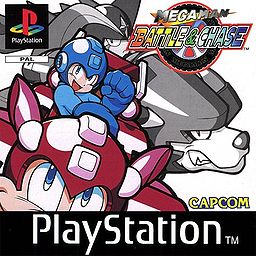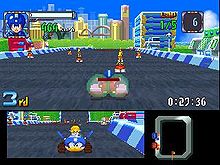- Mega Man Battle & Chase
-
Mega Man Battle & Chase 
European Box artDeveloper(s) Capcom Publisher(s) Capcom Distributor(s) - EU Infogrames
Producer(s) Keiji Inafune Designer(s) Masahiro Yasuma
Hayato TsuruComposer(s) Yoshinori Ono Platform(s) PlayStation Release date(s) Genre(s) Racing Mode(s) Single-player, multiplayer Media/distribution 1 CD-ROM Mega Man Battle & Chase, known in Japan as Rockman Battle & Chase (ロックマン バトル&チェイス), is a PlayStation racing video game based on the original Mega Man series from Capcom. The game was released in Japan on March 20, 1997 and in PAL territories in April 1998. Although it was not released individually in North America, Mega Man Battle & Chase was featured on the region-exclusive Mega Man X Collection in 2006. Mega Man Battle & Chase is a traditional racing game with an emphasis on combat. Winning a race allows the player to choose a car part from an enemy competitor as a prize. Reviews for the game have been mixed with many critics drawing comparisons to Nintendo's Mario Kart series.
Contents
Gameplay
Mega Man Battle & Chase is a 3D racing game in which the players compete against one another or the computer AI in a series of road races. The game consists of three different modes: a single-player "Grand Prix Mode", a "Time Trial Mode", and a multiplayer "Versus Mode". The Grand Prix mode contains a total of eight race tracks, while the Time Trial mode contains twelve tracks.[3] The game has ten playable characters from the original Mega Man series including Mega Man, Roll, Proto Man, Bass, Duo, and Dr. Wily, as well as a few of Wily's Robot Masters. Each of the characters possesses an innate ability that can be used for attacking other drivers during the race. A gauge on the left side of the screen will repeatedly charge and allow for another special power when fired. For example, Mega Man has the ability to shoot small projectiles from his vehicle. When the weapon gauge completely fills, the player can unleash a much larger and more destructive blast.
All the race tracks are littered with hazards and other obstacles that range from streetcones to giant, walking Mets. Rather than avoiding them, players are encouraged to make contact with them.[4] Running through or destroying ten of these hazards with a weapon will give the player a special item. These items have various effects such as giving the player a shield or disabling other drivers' weapons.[3] Winning races in the game's Grand Prix mode lets the player select a specific part (engine, wing, tire, or body) from the owner of the track, allowing for the customization of both the performance and appearance of the chosen character's vehicle.[3][4]
Development
Series artist and producer Keiji Inafune claimed that he had always wanted to "[bring] the unique 'beat your enemies and take their stuff aspect' of Mega Man to a racing cart game".[1] The game's character designs and promotion images were illustrated by Shinsuke Komaki and Hideki Ishikawa. The concept art for Guts Man in his Wild Arms racer was redone for the overseas version due to the original piece containing the character performing an offensive gesture.[1] The musical score for Mega Man Battle & Chase was composed by Yoshinori Ono and has vocals by Yoshino Aoki and Ryoji Yamamoto. This was one of Aoki's first projects at Capcom. She sang theme for the character Roll, Kaze yo Tsutaete (風よ伝えて, Wind, Carry My Words), which was used as both an ending theme and for the game's Japanese television commercial advertisement.[5] The second vocal ending theme A ~ Otoko Ichidai (あ~男一代, lit. "Ah, Man's Life") features Yamamoto as the character Guts Man.[6] A CD soundtrack for the game was released by Victor Entertainment in Japan on June 21, 1997.[7]
Mega Man Battle & Chase was released in Japan on March 20, 1997.[1] The developer Capcom had planned to release the game in North America the following month.[3] However, despite being advertised in numerous gaming magazines, Mega Man Battle & Chase did not pass approval from Sony Computer Entertainment for an individual release in North America due to an already large presence of mascot-themed racing games in the video game market.[8][9][10] An English adaptation of the game was released much later in PAL regions in April 1998.[2] In 2006, Mega Man Battle & Chase was included along with the first six Mega Man X games in the North American Mega Man X Collection for the PlayStation 2 (PS2) and GameCube.[11]
Reception
Critical reception for Mega Man Battle & Chase has been mixed. The gameplay has been almost universally compared to Nintendo's Mario Kart series.[3][4][10][12][13] GameSpot contributor Jeff Gerstmann was impressed by the Japanese version of the game. Gerstmann noted good graphics and interesting sound design, and concluded that it is "one of the coolest Mega Man games released. Period."[4] When reviewing the Mega Man X Collection, Phil Theobald of GameSpy found the graphics for Mega Man Battle & Chase to be dated, but that it was still fun to play and that the ability of the player to steal opponents' parts to use as their own further tied the game to Mega Man franchise.[12] IGN writer Jeremy Dunham similarly asserted, "I was actually surprised at how entertaining this little kart racer really is, and while it's not on par with something like Crash Team Racing or the legendary Mario Kart series, it's a nice change of pace with some cool tracks."[14] In his retrospective of the entire Mega Man game franchise, Jeremy Parrish of 1UP.com denoted the Mega Man Battle & Chase as "a simpleminded racer that is mainly notable for being the first truly shameless Mario Kart clone and for almost being released in the U.S. Though not worth a stand-alone purchase, it's tolerable as a few minutes' diversion as part of the Mega Man X Collection for PS2."[15]
References
- ^ a b c d Mega Man: Official Complete Works. Udon Entertainment. January 6, 2010. pp. 84–8. ISBN 978-1-89737-679-9.
- ^ a b "Tests: Mega Man Battle & Chase" (in German). Video Games (Markt Anfang): p. 89. April 1998.
- ^ a b c d e "Previews: Mega Man Battle & Chase". Electronic Gaming Monthly (Lombard, IL: Ziff Davis) (92): p. 36. March 1997.
- ^ a b c d Gerstmann, Jeff (April 29, 1997). "RockMan Battle & Chase Review". GameSpot. http://www.gamespot.com/ps/driving/rockmanbattlechase/review.html. Retrieved 2010-06-07.
- ^ Greening, Chris (December 2009). "Interview with Yoshino Aoki". Square Enix Music Online. http://www.squareenixmusic.com/features/interviews/yoshinoaoki.shtml. Retrieved 2010-07-05.
- ^ "Rockman Battle & Chase" (in Japanese). Capcom Friendly Club Style Fan-Book (Capcom) 3: p. 4. Spring 1997.
- ^ "Rockman Battle & Chase :: Album Information". Square Enix Music Online. http://www.squareenixmusic.com/albums/r/rockmanbattlechase.shtml. Retrieved 2010-07-05.
- ^ Oxford, Nadia (May 31, 2010). "Buy Somethin', Will Ya!: Mega Man's Forgotten Battle and Chase Ad". 1UP.com. http://www.1up.com/do/blogEntry?bId=9032290. Retrieved 2010-06-05.
- ^ IGN Staff (May 13, 1997). "MegaMan Killed?". IGN. http://psx.ign.com/articles/062/062624p1.html. Retrieved 2010-06-05.
- ^ a b Oxford, Nadia (May 24, 2007). "Mega Manniversary: Isle of Miscast Robots". 1UP.com. http://www.1up.com/do/feature?cId=3159797. Retrieved 2010-06-07.
- ^ Torres, Ricardo (December 9, 2005). "Mega Man X Collection Preview". GameSpot. http://www.gamespot.com/ps2/action/megamanxcollection/news.html?sid=6141022&om_act=convert&om_clk=newsfeatures&tag=newsfeatures;title;2&mode=previews. Retrieved 2010-06-05.
- ^ a b Theobald, Phil (January 9, 2006). "Mega Man X Collection". GameSpy. http://ps2.gamespy.com/playstation-2/mega-man-x-collection/679793p2.html. Retrieved 2010-06-08.
- ^ Major Mike (January 25, 2006). "Mega Man X Collection Review". GamePro. http://www.gamepro.com/article/reviews/51444/mega-man-x-collection. Retrieved 2010-06-09.
- ^ Dunham, Jeremy (January 5, 2006). "Mega Man X Collection - GameCube Review". IGN. http://cube.ign.com/articles/679/679253p2.html. Retrieved 2010-06-08.
- ^ Parish, Jeremy (May 10, 2007). "The Mega Man Series Roundup". 1UP.com. http://www.1up.com/do/feature?pager.offset=1&cId=3159344. Retrieved 2010-04-10.
External links
Mega Man franchise Mega Man series MainHandheldArcadeOtherWily & Right no RockBoard: That's Paradise · Mega Man Soccer · Mega Man Battle & Chase · Mega Man & Bass · Super Adventure RockmanMega Man X MainOtherMega Man Zero and ZX ZeroZXMega Man Legends Mega Man
Battle NetworkMainOtherMega Man Star Force Remakes and
compilationsCharacters Music Animation  Book:Mega ManCategories:
Book:Mega ManCategories:- 1997 video games
- Mega Man games
- PlayStation games
- Racing video games
Wikimedia Foundation. 2010.

